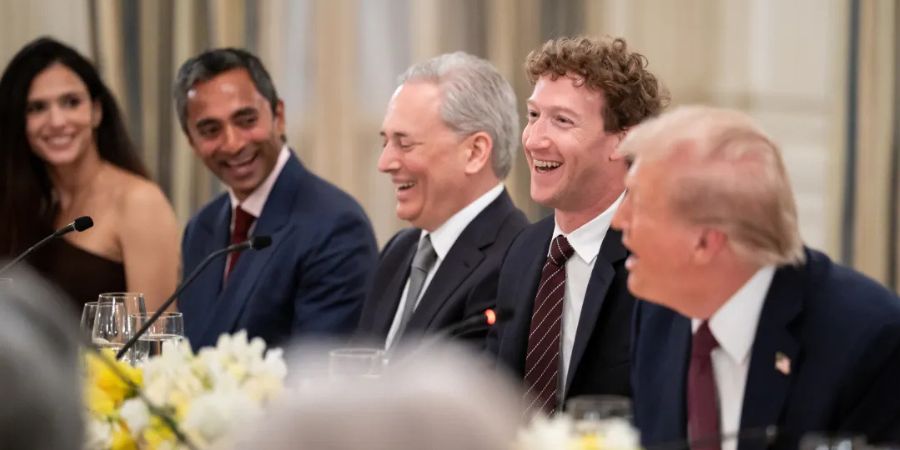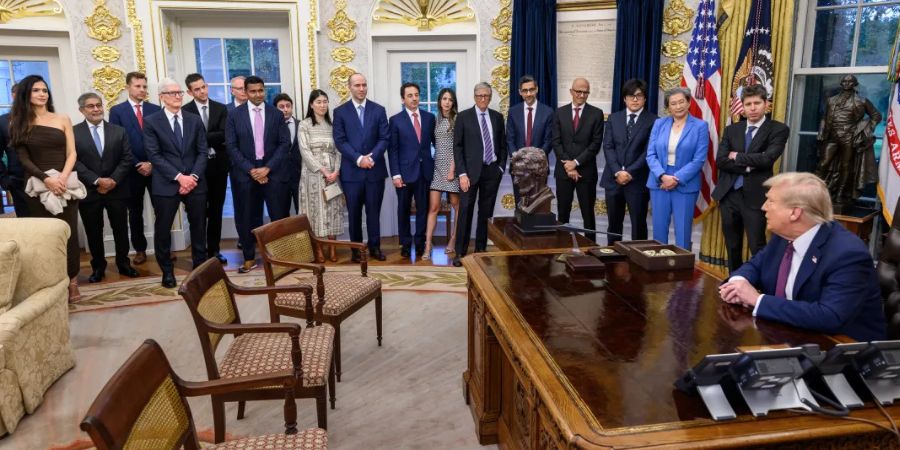Last week, the White House hosted a formal dinner with the world’s most influential technology leaders. At the center sat Donald Trump, positioning himself not only as host, but as the ultimate power broker.
The guest list included Microsoft founder Bill Gates and its current CEO Satya Nadella, Meta founder Mark Zuckerberg, Apple CEO Tim Cook, OpenAI’s Sam Altman, and Oracle’s CEO Safra Catz. (The implications of Elon Musk’s absence from this meeting could easily justify an entire column of their own.)
But the real lesson was not in the guest list. It was in how Trump framed the event. With complete control over the setting, the narrative, and the messaging, he once again displayed the essence of his style: dominance, authority, and framing the process.
World technology leaders – many of them heading corporations larger and more influential than entire nations, fully played along. Apple’s CEO Tim Cook, in a toast that went viral, expressed gratitude eight times in less than two minutes. Other executives followed the same tone, offering repeated thanks.
For CEOs, this evening was far more than a ceremonial gathering. It was a live lesson in how Trump leverages authority and positioning to create leverage. As always, he positioned himself at the center of influence, while the tech leaders aligned around him.
“I set the deal – they don’t”
A few months ago, in May, aboard Air Force One, Trump was asked about his trade talks. His sharp, characteristically “Trumpian” answer:
“I set the deal, they don’t.”
That single line captured the essence of Trump’s negotiation style: dominance, process control, and a reminder that he alone sets the rules.

It was no outlier. From tariff battles with China to rewriting NAFTA to walking away from the Hanoi summit, Trump repeatedly leaned on the same tools: projecting authority, creating unpredictability, and showing he was ready to walk. Leverage, in his view, was greatest when the other side was forced to react rather than lead.
For executives, the lesson is clear: sometimes framing the negotiation as “We set the terms” can be powerful especially if you control a unique asset, such as intellectual property or a critical supply chain. But it cannot be the only play in the book. Overuse turns an advantage into a liability.
Inconsistency as a Negotiation Tool.
The same themes were visible in 2025, when Trump’s administration engaged in direct talks in Doha over hostages and a potential ceasefire. Authorizing envoys to meet while simultaneously attacking the other side in public – going so far as to say “I think they want to die” – created a dynamic of total uncertainty.
Unpredictability is destabilizing. No one can anticipate whether the other side is extending a hand or preparing to walk away. At one stage, Trump’s envoy even withdrew the American team from the talks, citing a lack of seriousness. It was classic Trump: unpredictability and walk-away power deployed not only as outcomes but as tools to unsettle the other side.
For CEOs, the comparison is instructive. Inconsistency can shake assumptions and create leverage. But it also corrodes trust. Allies may lose confidence, opponents may stall, and opportunities may collapse under the weight of uncertainty. The value of such tactics lies in timing and leverage – not in endless repetition.
Context Matters
The danger for business leaders lies in forgetting the unique platform from which Trump operated. As U.S. president, he commanded near-absolute authority: his words moved markets, his position insulated him from most external checks, and his media visibility amplified every move.
A CEO, no matter how powerful, rarely enjoys such protection. Boards can veto, regulators can intervene, and competitors can offer alternatives. Copying Trump’s style without that institutional shield risks undermining credibility and damaging long-term relationships.
Yet one element can inspire: Trump’s sense of positioning. Entering negotiations with visible confidence, projecting strength, and maintaining composure in crises – can shift dynamics at the table. Especially at the start of negotiations or during moments of uncertainty, this posture creates stability within the organization and signals resilience to counterparts.
Trump’s use of power negotiation did not begin in the White House. In New York real estate during the 1980s, in licensing deals, in branding, and even in his use of bankruptcy law, the same pattern emerged: money, status, and influence leveraged to push deals as far as possible – simply because he could.
For CEOs, the takeaway is clear: negotiation for CEO is always shaped by the platform you stand on. Trump’s approach worked because his position gave him tools most leaders will never have – capital, visibility, and formal authority. Attempting to mimic that style without such insulation risks losing credibility, alienating partners, and undermining long-term trust.
But there is one element that CEOs can adopt: Trump’s sense of positioning. Entering negotiations with self-assurance, projecting self-power, and showing confidence in moments of uncertainty can shift dynamics at the table. Especially at the start of a negotiation or in times of crisis, that posture creates stability inside the organization and signals strength to counterparts—without crossing into the dangers of overreach.
The “TACO” Effect
Trump’s habit of issuing threats and then retreating gave rise to what commentators called the “TACO effect” – Trump Always Chickens Out. Markets eventually discounted his ultimatums, knowing many would not materialize. His recent tweet to Hamas, presenting a “last warning” ultimatum on the hostage release, is the same tool on display. In business, the consequences are even harsher. When a CEO overplays dominance and fails to deliver, credibility erodes, partners disengage, and future opportunities vanish.
Credibility is cumulative. It is not only about today’s deal, but also about the next one. A reputation for coercion or inconsistency drives others to seek alternatives. That is why negotiation for CEO must go beyond short-term wins; power plays may deliver headlines, but they can also create hidden costs that surface later.
Walking Away – The CEO’s Tool of Control
One Trump lesson remains crucial: the willingness to walk away. His decision to end the Hanoi summit with North Korea rather than sign a bad deal reinforced a critical truth: no deal is better than a harmful deal. CEOs must embrace the same principle.
In business, walking away is not a sign of weakness but of discipline. Done correctly, it reframes the negotiation and demonstrates power. But it must be planned, deliberate, and carefully managed. Walking away should never be an emotional outburstit should be an act of control, exercised only when the cost of no deal is clearly defined and fully acceptable.
A CEO who fails to prepare may find themselves “climbing a tree with no ladder,” forced into concessions just to climb down. By contrast, a CEO who identifies exit points in advance, communicates them strategically within the organization, and leaves with professionalism preserves credibility, strengthens bargaining power, and and can return later with an advantage.
Beyond Trump: The CEO’s Lesson
Trump’s declaration aboard Air Force One – “I set the deal, they don’t” – is a vivid reminder of both the appeal and the danger of power negotiation. His authority, wealth, and platform allowed him to push tactics most business leaders cannot sustain.
For CEOs, the true lesson is not to copy Trump’s dominance wholesale, but to distill what we can call the “Trump Position”. At its core, this position is about entering negotiations with visible confidence, framing the conversation on your terms, and demonstrating the discipline to walk away when conditions are not right. These elements can strengthen credibility and set a tone of authority without saying a word.
But the Trump Position also carries warnings. Overplaying power, relying too heavily on unpredictability, or assuming leverage that doesn’t exist can quickly backfire. Trust erodes, partnerships weaken, and opportunities close. The CEO’s challenge is to use confidence and framing as tools – while tempering them with preparation, foresight, and humility.
Effective negotiation for CEO is not about winning the moment – it is about ensuring the deal endures, and that partners want to return to the table again tomorrow. The Trump Position, wisely adapted, can inspire strength; misused, it can cost everything.
Yael Chayu is a global business negotiation expert, keynote speaker, and strategic advisor to executives across industries. She is a doctoral researcher in Behavioral Economics at Reichman University, where she also serves as Academic Director of the Business Negotiation Program at FORE Executive Education. Through www.yaelchayu.com she provides executives with advanced negotiation strategies to accelerate business performance and create lasting impact.





